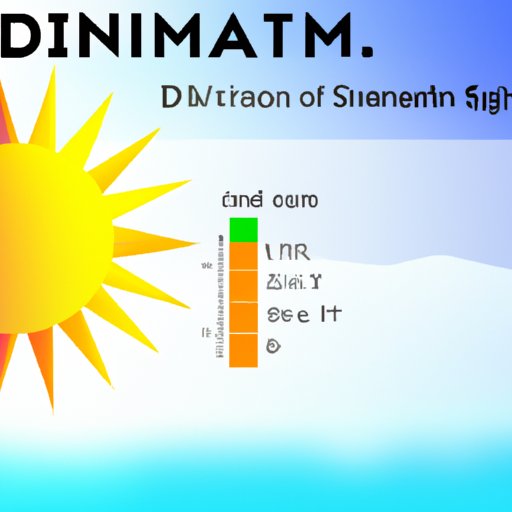
I. Introduction
Vitamin D is an essential nutrient that plays a vital role in many aspects of our health and is known as the “sunshine vitamin” because our bodies produce it in response to sunlight. However, as we all know, too much sun exposure can have harmful effects on our skin, and it is important to find a balance between sun exposure and maintaining optimal levels of vitamin D.
II. The Risks and Benefits of Sun Exposure: How Much Vitamin D is Too Much?
While the sun provides us with a necessary source of vitamin D, too much sun exposure can result in skin damage and increase the risk of skin cancer and premature aging. However, moderate exposure to sunlight has been linked to a variety of overall health benefits, including boosting our mood, reducing inflammation, and regulating our sleep patterns. Therefore, it is important to balance the risks and benefits of sun exposure to maintain optimum health.
It is commonly believed that 10-30 minutes of daily exposure to the sun is enough to produce an adequate amount of vitamin D without increasing the risk of harmful exposure. However, individual skin types, the time of day, and latitude can all affect the amount of sun exposure required, and guidelines should be followed according to local conditions.
III. The Science Behind Sunlight: How UV Rays Help Your Body Produce Vitamin D
When we are exposed to sunlight, the UVB rays penetrate our skin and interact with a form of cholesterol called 7-dehydrocholesterol, which triggers the production of vitamin D in our bodies. The vitamin D is then transported to the liver and kidneys where it is converted into its active form, which helps to regulate calcium and phosphate levels in our bodies.
While this process is the same regardless of skin color, people with darker skin tones absorb less UVB rays, which makes it more difficult for their bodies to produce enough vitamin D. Additionally, when exposed to the same amount of sunlight, those living at higher latitudes produce less vitamin D.
IV. Vitamin D and Sunlight: Debunking Common Myths and Misconceptions
There are many myths and misconceptions about vitamin D and sunlight, including the idea that sunscreen prevents all vitamin D production. While it is true that some sunscreens can limit the amount of vitamin D produced, applying a moderate level of sunscreen can still allow for sufficient UVB exposure to produce vitamin D.
Another common misconception is that people can get enough vitamin D through their diets. While dietary sources such as fatty fish and fortified foods can help maintain healthy vitamin D levels, it is difficult to get enough vitamin D from food alone.
V. Achieving Optimal Vitamin D Levels: Balancing Safe Sun Exposure and Dietary Sources
Fortunately, it is possible to maintain optimal vitamin D levels through safe sun exposure and dietary sources. For those living at latitudes with insufficient sunlight, supplements may be necessary. It is important to work with a healthcare provider when deciding which supplements are right for you, as too much vitamin D can also be harmful to your health.
As well as sunlight, vitamin D can also be found in many foods such as salmon, tuna, eggs, and fortified products such as breakfast cereals. These foods can help ensure a healthy balance of vitamin D levels, allowing us to maintain our optimal health.
VI. From Seasonal Affective Disorder to Osteoporosis: The Role of Vitamin D in Our Health and Well-being
Vitamin D plays a vital role in maintaining our overall health. It helps with the absorption of calcium and phosphate, which are essential in the development and maintenance of strong bones. Vitamin D has also been linked to the prevention of a variety of illnesses, including heart disease, diabetes, and certain types of cancers.
In addition to physical health, vitamin D has also been linked with mental health and well-being. Low levels of vitamin D have been linked to Seasonal Affective Disorder (SAD), a type of depression that often occurs in the winter months due to a lack of sun exposure. Adequate levels of vitamin D have also been associated with lower rates of anxiety and depression.
VII. Conclusion
While the sun is a primary source of vitamin D, it is important to find a balance between its benefits and risks. Too much sun exposure can increase the risk of skin damage and cancer and premature aging, while too little exposure can lead to a deficiency of vitamin D, resulting in a variety of health conditions. A healthy balance of safe sun exposure and dietary sources of vitamin D can help maintain optimal levels of vitamin D, contributing to overall health and well-being. As always, it is important to consult with a healthcare professional to ensure individualized needs are met.




